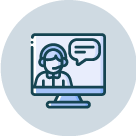
Childhood Apraxia of Speech
A child with Childhood Apraxia of Speech (CAS) may have difficulty learning new words or recalling vocabulary they already know because planning to speak takes longer for them than other kids their same age.
What is Childhood Apraxia of Speech?
Childhood Apraxia of Speech (CAS) is a motor speech disorder that affects the planning and production of oral movements. Childhood Apraxia of Speech can be identified by difficulties in controlling the lips, tongue, jaw, or voice box.
Researchers don't yet understand what might cause CAS. While some believe that it is related to a child's overall language development, others feel it is a problem with the brain's signals to the muscles needed for speech. Brain imaging tests have not found any fundamental differences in brain structure in children who have speech apraxia.
Childhood Apraxia of Speech is often misdiagnosed as Developmental Language Disorder.
This happens because it shares many similarities, such as age range (childhood), difficulty producing consonant sounds, and delayed expressive language skills.
Childhood Apraxia of Speech is often diagnosed in children between the ages of two and four. The earlier Childhood Apraxia of Speech is detected, the better chance a child can overcome it because they will have more time to practice and develop their speech skills.
How a speech-language pathologist can help with Childhood Apraxia of Speech:
Speech-language pathologists are trained to identify Childhood Apraxia of Speech (CAS). A speech-language pathologist will conduct a comprehensive assessment to determine if a child has CAS or another type of language disorder such as Developmental Language Disorder.
A thorough evaluation includes an oral-motor examination, perceptual analysis of speech errors, a language, and vocabulary evaluation.
Once Childhood Apraxia of Speech is diagnosed, the speech-language pathologist develops an individualized treatment plan based on their findings. The speech-language pathologist will design specific interventions to help improve their child's ability to plan and produce oral movements for speech sounds.
Treatment may include exercises to improve motor skills, oral-motor exercises, and strategies for increasing vocabulary or sentence length. A speech-language pathologist will work with the family on implementing procedures at home that can help promote speech development.
The goal of intervention is to reduce or correct Childhood Apraxia symptoms and increase functional communication skills in everyday communication situations.
Online Evaluations & Treatment From the Comfort of Your Home
THOROUGH ASSESSMENT
CAS is a very complex speech disorder. It can be challenging to diagnose and, therefore, cannot be analyzed in a single visit. Our speech-language pathologist will complete tests to assess your child’s ability to say different sounds and examine how your child moves their mouth during the assessment process. We will also test your child’s language skills (talking and understanding).
CUSTOMIZED GOAL & PLAN
Connected Speech Pathology’s speech pathologists are certified by the American Speech-Language-Hearing Association and trained to provide the best therapy methods for Apraxia of Speech. We will create a treatment program tailor-made for your child’s needs.
EFFECTIVE TREATMENT
Our speech-language pathologists will usually provide therapy that focuses on practicing syllables, words, and phrases. When Apraxia of Speech is relatively severe, your child may need frequent speech therapy up to three to five times a week. As your child improves, the frequency of therapy may be reduced.
-
Because children with CAS have difficulties planning movements for speech, Apraxia of Speech therapy involves directing your child’s attention to speech movements' sound and feel. You may be asked to be involved in your child's speech practice at home because between-session training is essential. If your child has a severe speech disorder and can't effectively communicate, alternative communication methods can be beneficial.
-
Your child’s treatment goals will be set by your speech-language pathologist to create meaningful outcomes that achieve real-life improvement.
Since each child is unique and will respond to different therapy methods, we will create a treatment program tailor-made for your child’s needs. We will choose the right therapy technique for each family and adapt therapy if your child does respond to a specific plan.
-
Our speech therapists at Connected Speech Pathology hold master’s degrees in communication sciences and have completed rigorous post-graduate training to provide the best therapy methods available. Our nationally certified team of speech-language pathologists are experts in pediatric communication and speech disorders.
-
That’s a common question. We will strive to make every therapy session feel productive. The trajectory of speech therapy interventions is different for each child, and there is no exact amount of time that applies to everyone.
Fees start at $75 per session, depending on each meeting’s length in 30, 45, or 60-minute increments. We are a private pay practice and do not accept insurance.
How do we meet?
Simple—we’ll meet online via our secure telehealth platform.
All that is needed to participate in online apraxia therapy is a computer or tablet and an internet connection. Our private video conferencing platform is free and easy to download. Your child will see your speech-language pathologist on the screen. The materials used for apraxia therapy are web-based, and at the click of a button, shared electronically with you right on your computer screen.
Some of the benefits of using online speech therapy:
The proximity of the camera to the mouth for modeling techniques
Receiving speech therapy from home eliminates transportation concerns and travel time
It removes the hassle of going to in-person appointments and improves attendance
It helps those who live in rural areas get the treatment they need
Allows for straightforward generalization of goals into everyday life
It’s fun and engaging!
How To Get Started:









